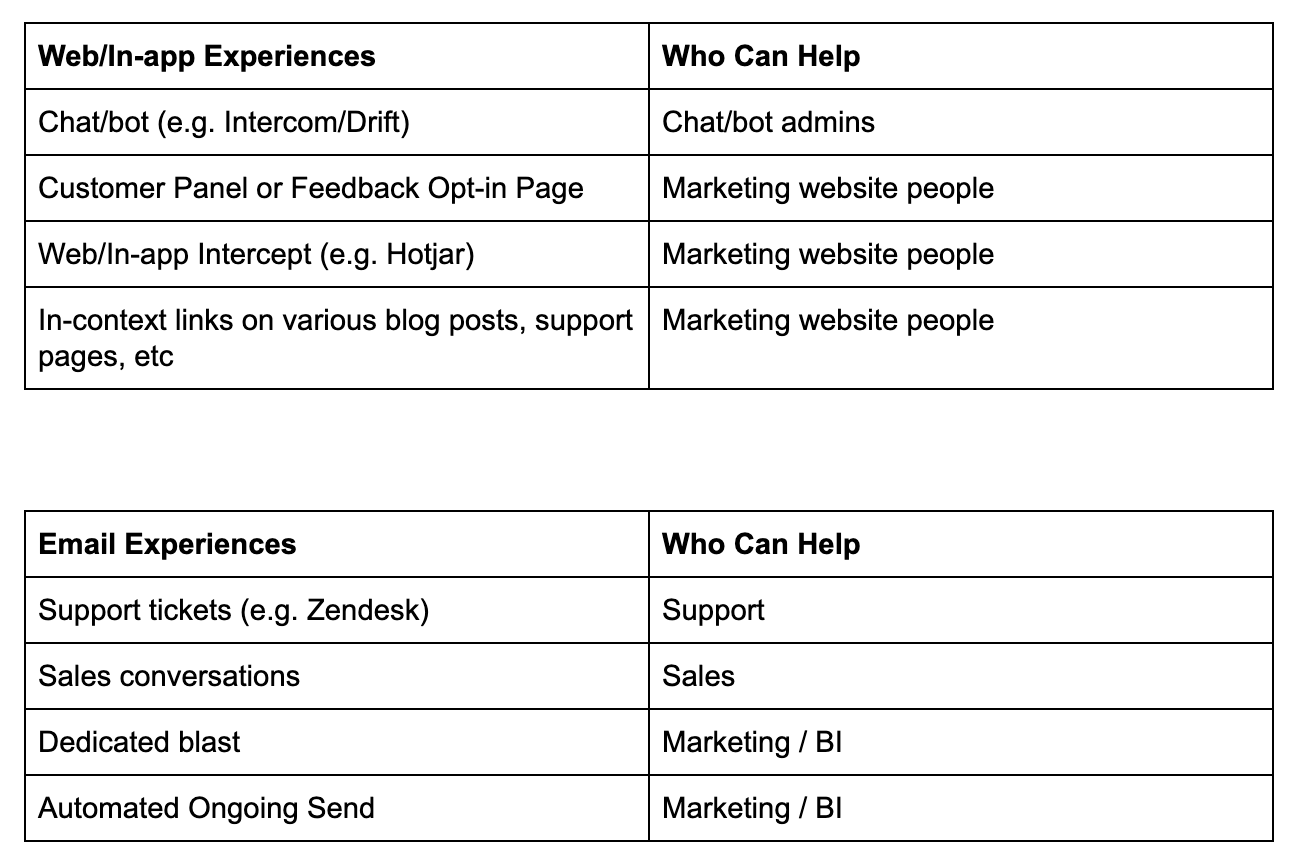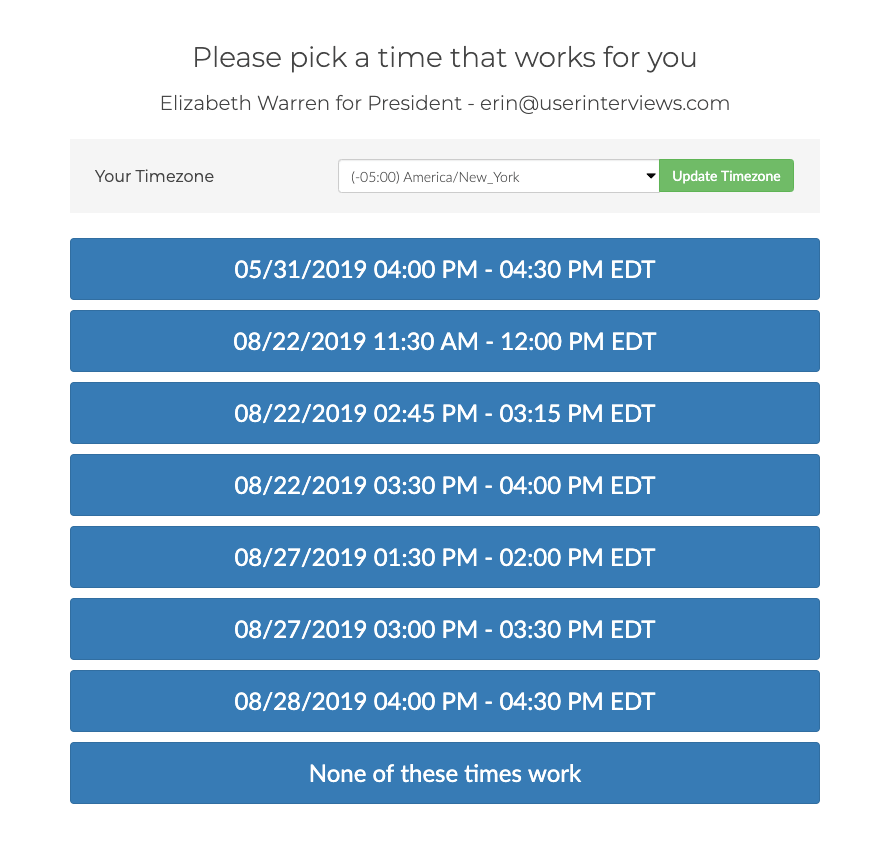Most researchers want to be doing more research (75% of them), and time is the biggest obstacle in doing more research, according to our ongoing interviews of researchers, designers, and product folks. Stick with me here, as I have a few tools I’m confident can help you get more research done in less time.
For a marketer, I conduct a lot of customer research, compared to what I gather is the normal amount. I make no claim on being the foremost expert on user research topics, but I do know a thing or two about building a research habit.
Teresa Torres, who we recently spoke with, knows way more than a thing or two about building a research habit. She teaches an entire course on continuous interviewing. You can listen to the full episode on continuous interviewing here 👇
In this article, I’m combining Teresa’s very practical ideas to get a constant stream of customer insight coming into your organization, our own experience building a research practice at User Interviews, and some toolage you can use to replicate/modify this process in your organization. Let’s go.
What to Talk to Customers About
Let’s start with what we’re going to talk to these customers about. The short answer is, whatever you want. Maybe you already know exactly where your questions are, and that’s what you can focus on. Maybe you don’t know where to start, or you’re new to this. In that case, take Teresa’s advice, and focus on one simple question, then dive deeper from there. For instance, you may ask “Tell me about the last time you X.” X can be:
- The last time they used your product
- The last time they had a problem your product is trying to solve
- The last time they felt motivated/inspired doing a task your product does/could help them do
These kinds of questions are open, lend themselves to storytelling, giving you lots of rich qualitative data to draw insights from, areas to dive deeper. But you can ask whatever questions are relevant to what you want to know. The point is to keep it simple and useful, so you always have something you can learn about when your research slots start filling up.
If you’re new to interviewing or more comfortable with a script to start off with, here’s a great guide to writing useful interview questions. Also make sure to listen to Teresa’s Awkward Silences episode ☝️ for tons of great tips on excavating insights with active listening skills.
How to Find Customers to Talk to (at least) Weekly
Teresa suggests that it’s good to talk to customers at least weekly. Less than that is hardly a habit, more than that may be too intimidating or time consuming to get this off the ground. (I’m using the term customers broadly to cover customers, users, prospective users—anyone you want to get insight from.) Alright, let’s find some customers.
Figure out where you can reach your customers/users right now
The best places to reach your customers on an ongoing basis are likely your website and email. More specifically, consider where you have a consistent volume of customers, and where you’ll have the easiest time getting access to that channel.

You could also talk to your friendly folks in BI and ask them to pull a list of customers you’re “allowed” to talk to. You know better than me who can help you access each channel—hopefully you can do it yourself for some of these! I recommend starting somewhere you have easy or direct access so you can get this going fast and with minimal bureaucracy. Show some wins, get some insights, and worry about expanding it to its full potential later on. Why do today what can be done tomorrow, amirite?
Get creative and think ongoing > one-off. For instance, can you ask your support team to create a macro/canned response for people with product feedback, encouraging them to sign up for product interviews? Can you create a dedicated page for this, linked in your website footer, so customers can find it themselves? What about adding a link in your marketing (or product marketing) email footers?
Here’s an automated email I send folks who have launched a 1st project with us, but after 45 days have not launched a 2nd project, well over our median time to launch a 2nd project.

I get several responses to this each week, full of lots of interesting data I share back with the team, but I also get 2-4 monthly interviews out of it. See that link at the bottom? We’ll get to how that works later, but for now, you want to think about ongoing moments and places you can reach your customers.
🏃 6 Strategies for Doing Faster User Research—Without Sacrificing Validity
Automate Your Weekly Research Conversations
Now let’s build a simple flow to get people scheduling themselves to talk to you regularly. Your beautiful, scalable, automated flow. 🙏
If you’re a User Interviews Research Hub customer, this is very simple to do. If you aren’t a Research Hub customer, your first month on the Bring Your Own plan is free. Just start a new project, and choose My Own participants.

Next, select 1:1 interview

Describe your ongoing interviews in the “set up project” step, like below.

Skip writing an invitation and building your screener survey steps to keep this really simple and fully automated. Trust me on this. We can move to 201 later.
When will your sessions be?
Are you going to be hosting these sessions on your own, or with a notetaker, or, as Teresa recommends, in groups that represent all your team’s functions—design, product manager, engineering?
Sync your calender in the provide schedule step, if you haven’t already. Then choose one or more weekly slots you would like to fill. If you know Tuesday at noon ET works for folks on your side, you can create that slot for as many weeks out into the future as you like and go ahead and block that time off everyone’s calendar. You could also block the time and whoever can join that week can join. Just come up with something repeatable you don’t have to think about every week.
Whatever sessions you create, your customers can sign up for. They cannot sign up for sessions that don’t exist. 🤔
Invite customers to schedule themselves for interviews
If you use User Interviews, you’ll get a link like this to share anywhere. Share your link in emails, on your website, or wherever you decided was going to be easiest and most impactful to get things going. That link will take whoever clicks on it to a sign up page like this:

Then they’ll land on a calendar page to sign up for times that work for them to connect.

You’ll end up with a calendar automagically filled (to your preference) with participants to talk to. Within User Interviews you can also customize follow-up and reminder emails with Zoom links or other practical details.
If you’d like to offer your customers some kind of incentive or thank you gift, you can also choose to have User Interviews automate paying incentives through Amazon gift cards, or you can handle those yourself. Not sure what to pay these folks? Check out our guide on research participant incentives. Keep in mind b2b/enterprise folks might prefer a donation, swag, discount on your service, or a simple private or public thank you.
Modify Above to Work for You
If this sounds TOO easy, feel free to make it more complicated. You can add a screener survey and use it to filter your participants initially, or accept all responses, and then segment who you accept when, based on your research priorities at the time. This is all especially useful for one-off research, but often less so if your goal is to automate an ongoing cadence of talking to your customers, which is our goal today.
What to Do with all This Data
While talking to your customers weekly, or even more often, is truly its own reward, you likely want to make some sense of all this unstructured data. There are many ways to tackle the organizing insights question, but one framework we love is Teresa’s Opportunity Solution Tree.

Constantly talking to your customers is an amazing way to broaden your opportunity space, to create incredible outcomes for your business and customers at the same time. You’ll no doubt start finding trends as you listen through your interviews that can be added to your outcome tree. To make that process easier, Teresa recommends a couple practical steps.
Step 1: Make an interview snapshot right after each interview
Create a simple one-page document, perhaps with a screenshot of your interview for a visual cue, that includes a summary of what you heard and learned. Here’s a basic template for taking notes you can copy if you don’t already have one you like. You can simply summarize your notes from there. Store them in a Google Drive or central, findable, digital place. If you have a tagging or other metadata system, great. You want to be able to find themes later.
Step 2: Periodically review your snapshots
Every couple of weeks, or as you’re evaluating new opportunities, look across your snapshots for trends and specific details around those trends to help you get to the best outcomes. For more on turning qualitative data into effective insights and deliverables, see our UX Research Field Guide module on research deliverables.
Don’t let perfect research be the enemy of good research
There are a thousand reasons not to get started with something like this, but there are a million to just do it. For a couple hours of investment, you could be well on your way to weekly interviews with customers, and that can be a total game changer for teams.




















